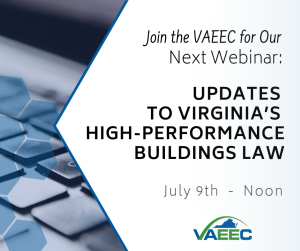Overview of the Updates to the High-Performance Buildings Act
 The High Performance Buildings Act of 2021 was enacted to drive more efficient, resilient, and future proof buildings. It updated the building performance standards for state and public buildings and created new building performance standards for local governments. During the 2024 General Assembly Session, the VAEEC and other stakeholders worked with the bill patron to update the law to better suit the localities’ needs and clarify unanswered questions.
The High Performance Buildings Act of 2021 was enacted to drive more efficient, resilient, and future proof buildings. It updated the building performance standards for state and public buildings and created new building performance standards for local governments. During the 2024 General Assembly Session, the VAEEC and other stakeholders worked with the bill patron to update the law to better suit the localities’ needs and clarify unanswered questions.
The major changes to the law, which takes effect July 1st, include:
- Clarification of the definition of “appropriate resilience features”. The bill language allows localities to identify potential hazards and determine what measures are effective to mitigate those risks to their specific buildings. This allows for more flexibility, as a coastal locality may have very different needs from one in the Piedmont or Southwest Virginia.
- Removal of the Virginia Energy Conservation and Environmental Standards (VEES) as a high performance building certification program, and inclusion of Earthcraft Light Commercial certification for buildings under 50,000 square feet. The VEES is not consistently updated, so removing it as a potential certification ensures deeper energy savings and higher standards in line with LEED, Earthcraft, and Green Globes.
- Specifying that the term “locality” is inclusive of school systems. In many Virginia cities and counties, the school system is a separate entity from the local government, which led to confusion about which buildings were included under the law.
- Closing loopholes in the definition of Zero Emission Vehicle (ZEV) charging infrastructure and the timeline for the design phase of a building. Both sections of the 2021 law included language that confused the intent of the law and made it easy to seek exemption from the requirements. The 2024 update strikes language around the number of charging stations and types of chargers required, and plainly states what types of equipment should be considered in the design phase of the building. It also adds a timeline for localities to enter the design phase after budgeting and contracting for the work.
- Clarification on how to adapt buildings that don’t qualify for high performance building standards, such as firehouses. The 2024 law now states that, if a building type is under 20,000 square feet and not eligible for certification, that the locality must model energy savings equivalent to the ENERGY STAR Target Finder value for the building type, or equivalent standards.
The 2024 update also includes sections that added definitions for “commissioning” and “major disruption” to further ensure that new and renovated public buildings are achieving maximum comfort, health, and energy savings, while also allowing the localities the flexibility to do what is best for their community.
For a deeper dive into the nuts and bolts of the High-Performance Buildings Act, register for our upcoming webinar on July 9th.
